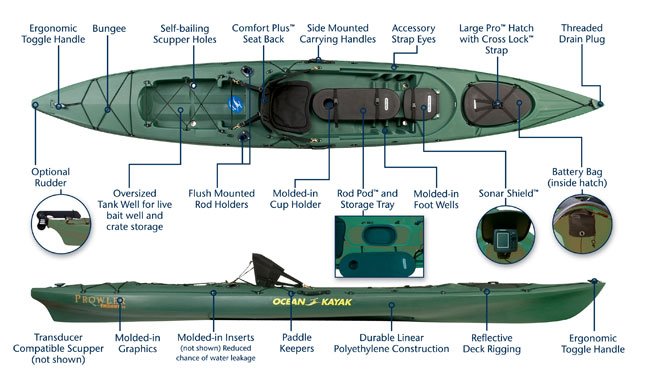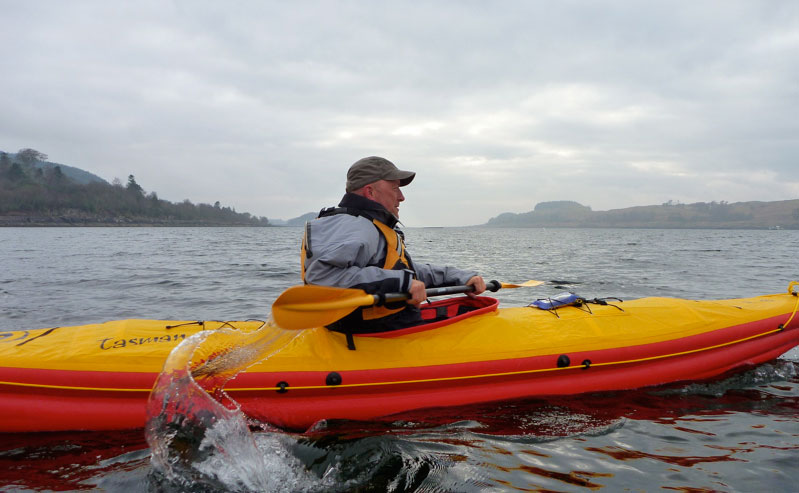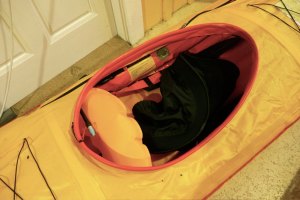Incept K40 Index Page
Missed the K40 intro? – it’s here.
For a brief test run, skip to this.
For initial impressions of my K40, go here.
With three months on the coast of northwest Scotland lined up for 2011 I was looking for a more seaworthy boat than the Sunny or making the Sunny faster (see this and this). Two weeks watching the weather blow through September 2010 showed it changes a lot up there. First from the east then the west, it blew at up to 50mph so when it’s good you’ve got to drop everything and get out there. But if it changes on the water while most probably paddling alone you want to be sure you can get back fast and not have to jeopardise making progress by either bailing in a frenzy or struggling to re-board. Well, that’s the way I see it.
In Shark Bay, it didn’t take much of a swell – maybe a metre – to fill the Sunny up every 20 minutes or so. I’d hook onto Jeff’s tandem and they paddled while I pumped. And that was the warm Indian Ocean not The Minch, off the North Atlantic.
It’s not like I’ll be setting off for St Kilda every weekend to pick up half a dozen gannet eggs, but either a deck or self-bailage is needed to be able to paddle alone around there with security.
As you do, over the previous months I gone through periodic frenzies of internet research. A hardshell SinK was never in the running. I don’t like being jammed in those things, they’re awkward to transport and would need getting rid of after. Plus I can rent a decent sea kayak locally.
Instead, I wondered about the other extreme, an SoT; very popular with the rec paddling masses who may not know a hard chine from a Chinese burn, but have a whole lot of inshore fun nevertheless. Most SoTs are wide enough to do the Can-Can while wearing flippers and come in awful ‘explosion-in-a-paint-factory’ colour schemes.
The angler-oriented models are less hideous and I narrowed it down to an Ocean Kayak Prowler 15 (above left) or OK’s slimmer Scupper Pro (above). One went on ebay for just 300 quid while I was thinking about where I could store it. They say an SP is from the same mould as an RTM Tempo (left; 24kg 4.5, on 67cm) and their Disco (below right; 23kg 4.3, on 65cm) looks pretty good too for a plastic sea clog (the shape I mean – not the colour). Fast I imagine, easy as a bike to get on and off, but might require suiting up too often to be fun without getting chilled. Either of these would be a lot of fun if I lived in Florida or the Aegean. Not so sure about northwest Scotland.
So according to my calculations that left a folder, and for me the pick of the bunch has always been Feathercraft’s Big Kahuna (left; 4.5m x 64cm; 16kg – 14′ 9″ x 25″; 35lbs) featuring an extra big cockpit for creaky old men who can’t bend like they used to could.
Feathercrafts are expensive and the marked up price new in the UK is so far beyond the pale to give them an admiring cachet among paddlers. I missed one in the UK for £1800 then tracked down another in Hawaii with every last option plus a few extras for £2200. I could have brought it back and then sold it in the UK for what it cost after 3 months paddling.
It then turned out matey down the road had a Big K so we went out for a spin on the local, freezing river this week. More about that here. Short version: the BK would be a flaming good yak that could be left assembled for the duration and wouldn’t get turned away by security at the Sea Kayak Christmas Ball. On the scungy Medway it took a bit of turning in my clumsy hands but tracked fine, glided smoothly and weighs only 16kg; easy enough to portage on the shoulder. But it still has that unnerving SinKiness I don’t like and is a bit awkward to get out of – well for a spaz like me with a dodgy shin and who’s used to IKs you can fall into drunk.
The Feathercraft would have been a lovely boat up in the Isles, but has the same re-entry issues as any SinK. The way I see it, if it’s bad enough that you tip over, getting back in and staying upright long enough to pump it out is going to take some luck alone. Until I learn how to roll a kayak I don’t fancy that at all.
Nevertheless, I was all set on buying the slinky BK as it would cost me nothing once sold on and doubtless have been a pleasure to behold. Then Gael from SSKT slapped me out of it and pointed out that Incept from NZ will be selling their decked K40 IK in the UK next year – and without a usual horrendous UK mark up (Knoydart take note…). UK distributors Seakayakoban tell me they have a demo in stock now with the next delivery in March for around £1500.
The K40 is similar to the Grabner Holiday II which might be classed as one of the original twin-side beam IKs which begat the Gumotex Seakers I and II. The solo Seaker 1 (left; 4.8m x 75cm – 18 inches more than a K40 and 3 inches wider) is officially as expensive as the K40, though has been going at half price ($1500) from Innova in the US.
A fellow IK blogger recently got one. At just £1000 that’s a great price, but the problem is the deck is fixed (packing and drying issues, IMO) and it manages to weigh no less than 33 kilos/73lbs according to the Gumo.cz website (US distributors Innova claim 60lbs/27kg). Whatever it is, I had a chance to buy a used Seaker from Czecho a year or two back for just £800, but pulled out when I appreciated you can’t take a boat that heavy on a plane too easily, nor haul it too far.

Readers have occasionally emailed me about decking a Sunny. It could be done I suppose by gluing velcro or a zip onto the sides or maybe some understraps, or even an elastic-edged canopy, like fitted bed sheets. How good will that look if I was left to do it?
It’s actually something that might be a little easier to achieve with a semi-decked Gumo Helios II (above left) were it not for those ghastly sewn-in seats they have. In fact I see Grabner offer such a thing with their Helios-like Explorer II (right; 5m x 75cm) as part of the €600 accessory package. Nein danke.
So, the Incept K40 Tasman
Like Gumotex, Aire, NRS and the rest, Incept seems to be an established raft manufacturer who’s turned to IKs. The Incept K40 Tasman (4.3m x 69cm; 17kg. 14′ 3″ x 27; 37lbs) seems to have been refined since I last looked at their website at which time there was no UK distribution that I could see. There seem to have been at least two other versions but this one looks the most complete by far and following this investigation I bought a K40.
I don’t know about you but for an IK, that picture below is of a pretty good looking boat. I do wonder about the 27-inch width, being used to the 30-inch Sunny, but at 30-inches I cannot imagine ever tipping out of a Sunny short of getting crossed up against a rock or branch a couple of times. If I measure 27 inches across my lap, it looks just right as long as you’re sat low. The simple answer is of course to go up to Oban for a demo.

Just like the Alpacka the K40 has a deck that zips across to one side to roll up for sunny, calm days. We like that about IKs; it keeps the legs tanned and makes packing, drying and, if necessary, draining the boat mid-water so much easier.


The hull is composed of three I-beamed chambers with twin-beam sides to help give its 14 feet better rigidity. The Sunny had round, single chamber sides which, although they get nice and taut on a hot day, the boat still flexes with the swell or even just with my weight in it. With I-beam chambers the K40 features pressure-relief valves on all three chambers including the sides rated at 5psi which are out of the water. This reduces the strain on the welded I-beam seams but it’s possible that some air will be purged through the valves as it expands in the course of a hot day. For this reason I see that Incept recommends carrying a small, top-up pump (right) as can be seen on the deck of the kayak pictured above. With it, you can re-pressurise the boat for maximum performance, and this can be done on the move as the valves (grey) are right there in the cockpit (the sidewall PRVs are behind the seat).
The twin beams also add up to less width (69cm or 27 inches – 3-4 inches less than my Sunny) and so more speed – although re-entry may be harder and all without – I hope – making it too tippy. It’s got a rudder because those high sides may catch a crosswind at times. Scoffed at by Brit sea kayakers who use boats that have hull profiles designed to turn when leaning out (very odd if you’re a motorbiker!), with a rudder you can paddle normally across the wind and use the rudder to correct the tracking.
A rudder will be good for sailing too. The boat also comes with a neoprene spray deck, a handy K-Pump and even thigh straps to enable control across a swell, better core muscle work-outs I reckon, and even eskimo rolling. In fact my boat came with no spray deck, no straps, no strap fittings (though there are markers), but it did have a K-Pump. Thigh straps are one thing I missed on a Sunny, more for the efficiency of paddling effort against the torso, than balance and control of tippiness (not a problem with that boat outside of hurricane conditions).
While getting the drum on the K40 I came across this video of a Kiwi guy who did an NZ South Island coast-to-coast over a fortnight. That is, upstream from the Tasman Sea, tough portage to a pass, then paddling down to the Pacific. (Ain’t these guys heard of packrafts!) His less driven mate came along in a 100-year old wooden replica boat – they were engaged in a historic C2C re-enactment using old and new craft.
It’s actually three, short videos of two guys having a little Kiwi back country adventure. Have a look at the K40 in action on vid II at 2:20. Many times on the rivers and seas you’ll see how a relatively modest waves wash over the deck of the K40 – a Gumo Sunny would be a brimming paddling pool at this point.
And again the vid reminds me of the advantages of an IK when it comes to bouncing off rocks and general abuse that would hurt a hardshell or loosen the joints of a taut folder like a Big Kahuna.


























